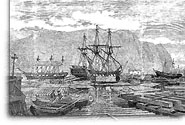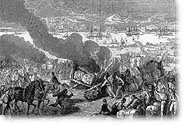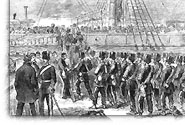Clouds on the British horizon
Lévis Forts National Historic Site
The European Threat

Boats during the loading of wood
© The Illustrated London News / 28 February 1863
One must look at political events in Europe to understand why a system of defence was set up on the south shore of Québec at the end of the 19th century. At the time, Britain had its hands full trying to quell several conflicts in the Mediterranean Basin and in a number of areas on the Continent.
One of their biggest concerns was the re-unification of Germany and the inevitable clash between the Germans and the Austrians. While Great Britain upheld its policy of non-intervention, the country was worried about not being able to continue getting its supplies of Scandinavian wood through the Baltic Sea. This became an even greater concern when, in February 1864, Prussia invaded Schleswig-Holstein, a duchy situated on the border between Germany and Denmark.

The cotton mill buildings
© Le Monde illustré /11th April 1863
England then considered returning to Québec, its old port of call.
In North America, the American Civil War that pitted the North against the South began in April 1861. From the start, England took a neutral stance.
The American Threat

The Northerners burn a convoy of cotton
© Le Monde illustré /11th April 1863
Great Britain wanted to protect its supply of raw cotton coming from the plantations in the South, but also did not want to compromise its relations with the Northern states who could easily seek reprisal through Canada. So when the North blocked cotton shipments, England was forced to turn to its colonies in India and Egypt to supply its mills. Then as the South advanced, winning one victory after another, Britain and United Canada feared that the North would try making up for its lost possessions by moving into Canadian territory.
A diplomatic incident would soon upset the delicate balance. On November 8, 1861, the British mail boat, the Trent, was accosted by an American war vessel (North). Once aboard, the Americans seized two Southern diplomats. The incident provoked outrage in England and two months later, 11,000 soldiers were sent out to Canada to defend the colony.

Boarding of British soldiers for United Canada
© The Illustrated London News / 14th December 1861
The American Civil War increased tensions to such an extent that in 1864, the Americans refused to renew the Reciprocity Treaty. Relations between United Canada and the United States were quickly deteriorating. The climate was such that the British colonies in North America felt the need to group together. On the eve of Confederation, Great Britain was facing trouble in Europe and also wished to protect its interests in the North American colonies.
- Date modified :